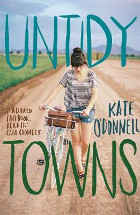Untidy towns by Kate O'Donnell

UQP, 2017. ISBN 9780702259821
(Age: 12+) Highly recommended. Themes: Rural life, Private schools,
Future, Relationships, Conformity, Friendship. Abruptly leaving her
city private school in March during her year twelve is scholarship
girl, Adelaide's best move. She has endured this place since year
seven, putting up with the slights from other girls, the meaningless
relationships and the push to strive and do well to represent the
school, to conform, toe the line, and behave. But suddenly she no
longer wants to be the girl they want her to be, so catches the
train and goes back home to Emyvale near Geelong. Mum meets her at
the station, and there follows a blossoming of her place in the
world, a realisation that she can do what she wants. She becomes the
intern at her grandfather's history museum in their small town, a
step towards fending for herself, of finding her path.
She meets the people she went to primary school with, rekindling
relationships from long ago with relative ease.
Her family does not pressure her to do anything she doesn't want to
do, allowing her space to find out what it is she really wants,
while she finishes her studies long distance and applies for a uni
course for the following year, to keep her options open.
When Mia comes to stay during the school holidays, things change.
She becomes involved with Addie's old friend, Jen and the two work
out how they can see each other at uni the following year. Adelaide
becomes embroiled in her relationship with Jarrod, to such an extent
that people are expecting them to become more of a couple and stay
in the town. Adelaide has a melt down and they argue but in making
up, she realises that this is the jolt she needs to do something.
Exam results, New Year, and uni offers for some the following year
are the background to the last chapters of this engaging novel about
making choices, making your own path in life, making decisions about
your own future.
Lashed with humour and stories of the town the whole is a diverting
look at people with hard decisions to make about their futures. Told
in chapters following the months from March to January, the
chronology of the book invites the reader to compare it with their
own path and decision making in what many see as a crucial year.
Seeing past what others want for her is part of the mix.
The cover compels the reader to pick up the book, eager to see what
the young girl will do in her untidy town. The design, font and
illustration stand out on shelves full of books with unremarkable
covers, and once inside the readers will be unable to put the book
down. A choice made through good design.
And I love the list of books read and those still to read at the end
of the book.
Fran Knight